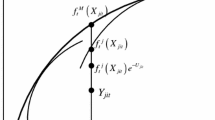Abstract
Introduced in the 1970s and refined at the beginning of the 2000s, the concept of meta-frontier is now recognized as the most popular operations research technique to deal with technology heterogeneity when conducting an efficiency analysis. As proof, the number of publications has followed an exponential trend with almost 800 publications overall. In short, the concept is based on partitioning DMUs into groups where each group uses its technology. The meta-frontier is defined as the envelopment of the group-specific counterparts. Technology gap ratios are evaluated to distinguish inefficiency behaviours from technological differences. After 20 years of applications and extensions, it is now time to assess the impact of the meta-frontier in the efficiency analysis literature. In this paper, we present a systematic literature review of the concept of meta-frontier. We cover several important aspects such as its origins, developments, and applications, and discuss technical considerations. An important focus will be made on how the partitioning of the DMUs into groups is made in practice; a crucial aspect of the meta-frontier technique. Beyond a simple literature review, this paper represents a guideline and toolkit for practitioners.






Similar content being viewed by others
Notes
We highlight the existence of the Free Disposable Hull (FDH after Tulkens 1993) that, contrary to DEA, is not based on a convex technology. Nevertheless, the popularity of DEA is incomparable to the one of FDH.
We highlight that Web of Science is now owned by Clarivate. We have mainly used three sub-datasets since they are directly relevant to our research topic: Science Citation Index Expanded (SCIE), Social Sciences Citation Index, and Arts & Humanities Citation Index (A &HCI).
Fields are those given by Scimago. For better readability, we adopt the following categories: A: Business, Management and Accounting; B: Energy; C: Engineering; D: Environmental Science; E: Computer Science; F: Social Sciences; G: Economics, Econometrics and Finance; H: Decision Sciences; I: Mathematics; J: Medicine; K: Agricultural and Biological Sciences; L: Psychology; M: Multidisciplinary; N: Health Professions; O: Nursing; P: Biochemistry, Genetics and Molecular Biology; Q: Earth and Planetary Sciences; R: Arts and Humanities; S: Psychology.
The averages, 760.75 and 2954.05, respectively, are less informative in that case because of applications using very large samples.
The following groups appear only in one paper: branch, career, collaboration, complexity, gene, playing position, risk, sex, star number, and water use.
The following DMUs appear only in one paper: buildings, CEOs, chains, children, councils, departments, distributors, districts, equity funds, fisheries, franchises, greenhouses, management systems, meals, menus, owners, parcels, pharmacies, platforms, players, programs, projects, providers, regencies, responses, services, shops, smartphones, terminals, towns, vessels, villages, years, and zones.
References
Aigner D, Lovell CK, Schmidt P (1977) Formulation and estimation of stochastic frontier production function models. J Econom 6:21–37
Birkle C, Pendlebury DA, Schnell J, Adams J (2020) Web of Science as a data source for research on scientific and scholarly activity. Quant Sci Stud 1(1):363–376
Charnes A, Cooper WW, Rhodes E (1978) Measuring the efficiency of decision making units. Eur J Oper Res 2:429–444
Cooper WW, Seiford LM, Tone K (2007) Data envelopment analysis: a comprehensive text with models, applications, references and DEA-solver software, 2nd edn. Springer, Berlin
Emrouznejad A, Yang GL (2018) A survey and analysis of the first 40 years of scholarly literature in DEA: 1978–2016. Socioecon Plann Sci 61:4–8
Lampe HW, Hilgers D (2015) Trajectories of efficiency measurement: a bibliometric analysis of DEA and SFA. Eur J Oper Res 240:1–21
Liu W (2019) The data source of this study is Web of Science Core Collection? Not enough. Scientometrics 121:1815–1824
Liu W (2023) Retrieval strategy and possible explanations for the abnormal growth of research publications: re-evaluating a bibliometric analysis of climate change. Scientometrics 128:853–859
Mongeon P, Paul-Hus A (2016) The journal coverage of Web of Science and Scopus: a comparative analysis. Scientometrics 106:213–228
Tsionas MG (2023) Clustering and meta-envelopment in data envelopment analysis. Eur J Oper Res 304(2):763–778
Tulkens H (1993) On FDH analysis: some methodological issues and applications to retail banking, courts and urban transit. J Prod Anal 4:183–210
Walheer B (2023) Meta-frontier and technology switchers: a nonparametric approach. Eur J Oper Res 305:463–474
Acknowledgements
We wish to thank the Editor-In-Chief Nikolaos Fragkiskos Matsatsinis, the anonymous referees, and Thibault Piron for their comments that substantially improved the paper. This work is supported by the Fonds de la Recherche Scientifique (FNRS) under Grant No. J.0193.23.
Author information
Authors and Affiliations
Corresponding author
Ethics declarations
Conflict of interest
The authors declare that they have no conflict of interest.
Ethical approval
This article does not contain any studies with human participants or animals performed by any of the authors.
Additional information
Publisher's Note
Springer Nature remains neutral with regard to jurisdictional claims in published maps and institutional affiliations.
Supplementary Information
Below is the link to the electronic supplementary material.
Appendix
Appendix
References related to the literature review about the concept of meta-frontier for the period 1969–2021 are given per year in the attached Online Appendix.
Rights and permissions
Springer Nature or its licensor (e.g. a society or other partner) holds exclusive rights to this article under a publishing agreement with the author(s) or other rightsholder(s); author self-archiving of the accepted manuscript version of this article is solely governed by the terms of such publishing agreement and applicable law.
About this article
Cite this article
Walheer, B. Meta-frontier: literature review and toolkit. Oper Res Int J 24, 20 (2024). https://doi.org/10.1007/s12351-024-00830-z
Received:
Revised:
Accepted:
Published:
DOI: https://doi.org/10.1007/s12351-024-00830-z




